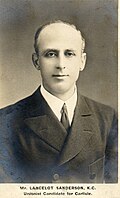The borough (1295–1832)
The parliamentary borough of Appleby consisted of the town of Appleby, the county town of Westmorland, and was consistently represented in the House of Commons from the Model Parliament of 1295 until the Reform Act 1832. [1] [2] [3] [4] [5] [6] [7] [8] [9] [10] [11] [12]
The right to vote rested with the occupiers of around a hundred burgage tenements. By the 18th century, the majority of the burgages were owned by the Lowther and Tufton families, which enabled them to put in reliable tenants at election time and ensure their complete control of who was elected. The seats were frequently kept for members of those families, but Appleby's other representatives included William Pitt the Younger, who was MP for Appleby when he became prime minister in 1783 (although he stood down at the following general election when he was instead elected for Cambridge University).
A later member for Appleby was Viscount Howick, subsequently (as Earl Grey) the Prime Minister whose administration passed the Great Reform Act 1832; but Grey's history as a former MP for the town did not save it from losing both its members under the act. Appleby was regarded as a classic example of a pocket borough, completely in the control of its owners who were also the major local landowners, and with a population of only 1,233 at the 1831 census unlikely to be freed from their influence even by widening the franchise. Nevertheless, as the only county town to be disfranchised, Appleby was one of the more controversial cases in the debates on the reform bill, the opposition making unsuccessful attempts to amend the bill so as to save at least one of its MPs.
After abolition the borough was absorbed into the Westmorland county constituency.




